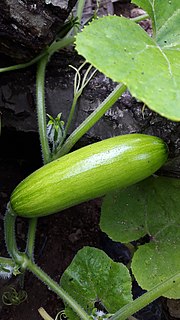 W
WAehobak, also called Korean zucchini or Korean courgette, is an edible, green to yellow-green summer squash. Although nearly all summer squashes are varieties of Cucurbita pepo, aehobak belongs to the species Cucurbita moschata. Commonly used in Korean cuisine, an aehobak has the shape of zucchini, but with thinner, smoother skin, and more delicate flesh. It is usually sold in shrink-wrapped plastic.
 W
WThe Armenian cucumber, Cucumis melo var. flexuosus, is a type of long, slender fruit which tastes like a cucumber and looks somewhat like a cucumber inside. It is actually a variety of muskmelon, a species closely related to the cucumber. It is also known as the yard-long cucumber, snake cucumber, snake melon, tirozî in Kurdish, uri in Japanese, acur in Turkish, kakadee in Hindi, tar in Punjabi, طرح in Arabic, commarella or tortarello in Italian. It should not be confused with the snake gourds. The skin is very thin, light green, and bumpless. It has no bitterness and the fruit is almost always used without peeling. It is also sometimes called a gutah.
 W
WThe asparagus bean is a legume cultivated for its edible green pods containing immature seeds, like the green bean. It is also known as: yardlong bean, pea bean, long-podded cowpea, Chinese long bean, snake bean, and bodi/bora. Despite the common name of "yardlong", the pods are actually only about half a yard long, so the subspecies name sesquipedalis is a more accurate approximation.
 W
WThe ackee, also known as ankye, achee, akee, ackee apple or ayee is a fruit of the Sapindaceae soapberry family, as are the lychee and the longan. It is native to tropical West Africa. The scientific name honours Captain William Bligh who took the fruit from Jamaica to the Royal Botanic Gardens in Kew, England in 1793. The English common name is derived from the West African Akan akye fufo.
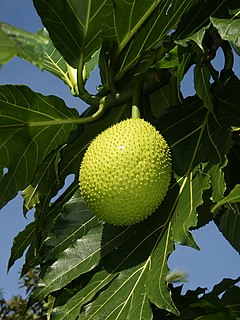 W
WBreadfruit is a species of flowering tree in the mulberry and jackfruit family (Moraceae) believed to be a domesticated descendant of Artocarpus camansi originating in New Guinea, the Maluku Islands, and the Philippines. It was initially spread to Oceania via the Austronesian expansion. It was further spread to other tropical regions of the world during the Colonial Era. British and French navigators introduced a few Polynesian seedless varieties to Caribbean islands during the late 18th century. Today it is grown in some 90 countries throughout South and Southeast Asia, the Pacific Ocean, the Caribbean, Central America and Africa. Its name is derived from the texture of the moderately ripe fruit when cooked, similar to freshly baked bread and having a potato-like flavor.
 W
WCalabash, also known as bottle gourd, white-flowered gourd, long melon, New Guinea bean and Tasmania bean, is a vine grown for its fruit. It can be either harvested young to be consumed as a vegetable, or harvested mature to be dried and used as a utensil, container, or a musical instrument. When it is fresh, the fruit has a light green smooth skin and white flesh.
 W
WCalabaza is the generic name in the Spanish language for any type of pumpkin. Within an English-language context it specifically refers to what is known as West Indian pumpkin or also calabassa, a winter squash typically grown in the West Indies, tropical America, and the Philippines. Calabaza is the common name for Cucurbita moschata in Cuba, Florida, Puerto Rico, and the Philippines. C. moschata is also known as auyama in the Dominican Republic; ayote in Central America; zapallo in South America; and "pumpkin", "squash", or "calabash" in English-speaking islands.
 W
WChayote, also known as mirliton, güisquil, pipinola and choko, is an edible plant belonging to the gourd family, Cucurbitaceae. Chayote was one of the several foods introduced to the Old World during the Columbian Exchange. Also during this period, the plant spread from Mesoamerica to other parts of the Americas, ultimately causing it to be integrated into the cuisine of many other Latin American nations.
 W
WChi qua is the fruit of Benincasa hispida var. chieh-qua, a variety of the wax gourd. The fruit is a staple of Chinese diet.
 W
WCoccinia grandis, the ivy gourd, also known as scarlet gourd, tindora and kowai fruit, is a tropical vine. It grows primarily in tropical climates and is commonly found in the southern Indian states, where it forms a part of the local cuisine. Coccinia grandis is cooked as a vegetable.
 W
WCooking bananas are banana cultivars in the genus Musa whose fruits are generally used in cooking. They may be eaten ripe or unripe and are generally starchy. Many cooking bananas are referred to as plantains or green bananas, although not all of them are true plantains. Bananas are treated as a starchy fruit with a relatively neutral flavour and soft texture when cooked. Bananas fruit all year round, making them a reliable all-season staple food.
 W
WCordia is a genus of flowering plants in the borage family, Boraginaceae. It contains about 300 species of shrubs and trees, that are found worldwide, mostly in warmer regions. Many of the species are commonly called manjack, while bocote may refer to several Central American species in Spanish. The generic name honours German botanist and pharmacist Valerius Cordus (1515–1544). Like most other Boraginaceae, the majority have trichomes (hairs) on the leaves.
 W
WCucumber is a widely-cultivated creeping vine plant in the Cucurbitaceae gourd family that bears usually cylindrical fruits, which are used as vegetables. Considered an annual plant, there are three main varieties of cucumber — slicing, pickling, and burpless/seedless — within which several cultivars have been created. The cucumber originates from South Asia, but now grows on most continents, as many different types of cucumber are traded on the global market. In North America, the term wild cucumber refers to plants in the genera Echinocystis and Marah, though the two are not closely related.
 W
WCucumber juice is the juice derived from cucumbers produced by squeezing or pressing it. Cucumbers are 98% water.
 W
WCucumis anguria, commonly known as maroon cucumber, West Indian gherkin, maxixe, burr gherkin, cackrey, and West Indian gourd, is a vine that is indigenous to Africa, but has become naturalized in the New World, and is cultivated in many places. It is similar and related to the common cucumber (C. sativus) and its cultivars are known as gherkins.
 W
WCucumis prophetarum is a dioecious and prostrate or climbing perennial vine in the family Cucurbitaceae.
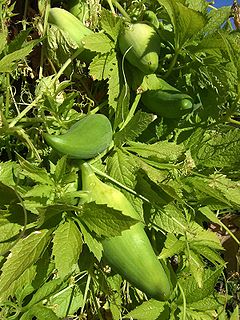 W
WCyclanthera pedata, known as caigua, is a herbaceous vine grown for its edible fruit, which is predominantly used as a vegetable. It is known from cultivation only, and its use goes back many centuries as evidenced by ancient phytomorphic ceramics from Peru depicting the fruits.
 W
WEggplant, aubergine or brinjal is a plant species in the nightshade family Solanaceae. Solanum melongena is grown worldwide for its edible fruit.
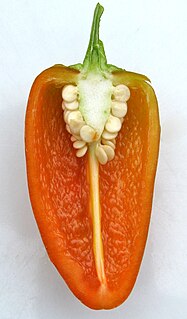 W
WThe Fresno chile or Fresno chili pepper is a medium-sized cultivar of Capsicum annuum. It should not be confused with the Fresno Bell pepper. It is often confused with the jalapeño pepper but has thinner walls, often has milder heat, and takes less time to mature. It is, however, a New Mexico chile, which is genetically distinct from the jalapeño and it grows point up, rather than point down as with the jalapeño. The fruit starts out bright green changing to orange and red as fully matured. A mature Fresno pepper will be conical in shape, 2 inches long, and about 1 inch in diameter at the stem. The plants do well in warm to hot temperatures and dry climates with long sunny summer days and cool nights. They are very cold-sensitive and disease resistant, reaching a height of 24 to 30 inches.
 W
WGarcinia pedunculata, popularly known as Bor Thekera in Assamese, is an evergreen tree related to the more familiar purple mangosteen. The tree is endemic to the south-eastern regions of Asia such as parts of Myanmar and north-eastern parts of India.
 W
WThe jalapeño is a medium-sized chili pepper pod type cultivar of the species Capsicum annuum. A mature jalapeño chili is 5–10 cm (2–4 in) long and hangs down with a round, firm, smooth flesh of 25–38 mm wide. It can have a range of pungency, with Scoville heat units of 3,500 to 8,000. Commonly picked and consumed while still green, it is occasionally allowed to fully ripen and turn red, orange, or yellow. It is wider and generally milder than the similar Serrano pepper.
 W
WLuffa is a genus of tropical and subtropical vines in the cucumber family (Cucurbitaceae).
 W
WLuffa acutangula is a cucurbitaceous vine that is commercially grown for its unripe fruits as a vegetable. Mature fruits are used as natural cleaning sponges. Its fruit slightly resembles a cucumber or zucchini with ridges. It ranges from central and eastern Asia to southeastern Asia. It is also grown as a houseplant in places with colder climates. English common names include angled luffa, Chinese okra, dish cloth gourd, ridged gourd, sponge gourd, vegetable gourd, strainer vine, ribbed loofah, silky gourd, silk gourd, and sinkwa towelsponge.
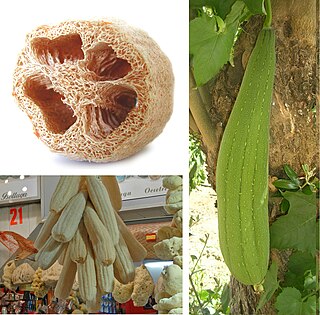 W
WLuffa cylindrica, the sponge gourd, Egyptian cucumber or Vietnamese luffa, is an annual species of vine cultivated for its fruit, native to South and Southeast Asia.
 W
WMaize, also known as corn, is a cereal grain first domesticated by indigenous peoples in southern Mexico about 10,000 years ago. The leafy stalk of the plant produces pollen inflorescences and separate ovuliferous inflorescences called ears that yield kernels or seeds, which are fruits.
 W
WA marrow is a vegetable, the mature fruit of certain Cucurbita pepo cultivars. The immature fruit of the same or similar cultivars is called courgette or zucchini. Like courgettes, marrows are oblong, green squash, but marrows have a firm rind and a neutral flavour, making them useful as edible casings for mincemeat and other stuffings. They can be stored for several weeks after harvest, to be processed for food when required. They are a vegetable used in Great Britain and areas with significant British influence, though their popularity is waning in favor of immature summer squash like courgette.
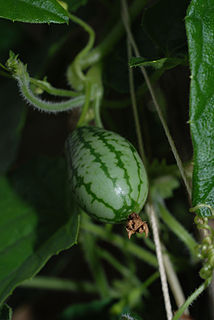 W
WMelothria scabra, commonly known as the cucamelon, Mexican miniature watermelon, Mexican sour cucumber, Mexican sour gherkin, mouse melon, or pepquinos, is a species of flowering plant in the cucurbit family grown for its edible fruit. Its native range spans Mexico to Venezuela. Fruits are about the size of grapes and taste like cucumbers with a tinge of sourness. It has been eaten by indigenous peoples since before Western colonization of the Americas began.
 W
WMomordica charantia is a tropical and subtropical vine of the family Cucurbitaceae, widely grown in Asia, Africa, and the Caribbean for its edible fruit. Its many varieties differ substantially in the shape and bitterness of the fruit.
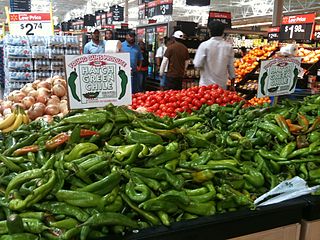 W
WNew Mexico chile or New Mexican chile is a cultivar group of the chile pepper from the US state of New Mexico, first grown by Pueblo and Hispano communities throughout Santa Fe de Nuevo México. These heritage chile plants were used to develop the modern New Mexico chile peppers by horticulturist Dr. Fabián García and his students, including Dr. Roy Nakayama, at what is now New Mexico State University in 1894. New Mexico chile, which typically grows from a green to a ripened red, is popular in the cuisine of the Southwestern United States, the broader Mexican cuisine, and Sonoran and Arizona cuisine, and an integral staple of New Mexican cuisine. Chile is one of New Mexico's state vegetables, and is referenced in the New Mexico state question "Red or Green?".
 W
WOriental pickling melon, called wolgwa in Korean, and shirouri in Japanese, is a group of nonsweet melon cultivars used in Asian cuisines.
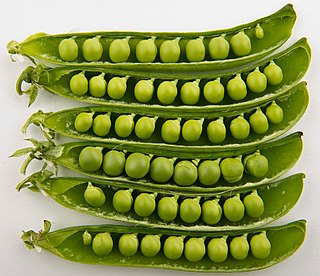 W
WThe pea is most commonly the small spherical seed or the seed-pod of the pod fruit Pisum sativum. Each pod contains several peas, which can be green or yellow. Botanically, pea pods are fruit, since they contain seeds and develop from the ovary of a (pea) flower. The name is also used to describe other edible seeds from the Fabaceae such as the pigeon pea, the cowpea, and the seeds from several species of Lathyrus.
 W
WPhysalis peruviana, is a South American plant native to Peru, Ecuador and Colombia in the nightshade family (Solanaceae), commonly known as Cape gooseberry or goldenberry, known in their countries of origin as uchuva, and in Hawaii called poha, in addition to numerous indigenous and regional names. The history of P. peruviana cultivation in South America can be traced to the Inca. It has been cultivated in England since the late 18th century, and in South Africa in the Cape of Good Hope since at least the start of the 19th century. Widely introduced in the 20th century, P. peruviana is cultivated or grows wild across the world in temperate and tropical regions.
 W
WPhysalis pruinosa is a plant in the genus Physalis in the nightshade family Solanaceae, often referred to as ground cherry or husk tomato. It is a native species in a range extending from northern Mexico through Central America. The plant has a low, spreading habit, and fruits develop in a papery husk, as is characteristic of the genus. While most parts of the plant are toxic to humans due to the presence of solanine and solanidine, the fruit becomes edible once it has ripened to yellow. The fruit's flavor is similar in some respects to that of a ripe tomatillo, but notably has a strong flavor of pineapple as well, a fact reflected in the name of a common commercial variety, "Cossack Pineapple".
 W
WA pumpkin is a cultivar of winter squash that is round with smooth, slightly ribbed skin, and is most often deep yellow to orange in coloration. The thick shell contains the seeds and pulp. The name is most commonly used for cultivars of Cucurbita pepo, but some cultivars of Cucurbita maxima, C. argyrosperma, and C. moschata with similar appearance are also sometimes called "pumpkin".
 W
WShishito pepper is a mildly spicy, East Asian pepper variety of the species Capsicum annuum. It is known as kkwari-gochu in Korea because its wrinkled surface resembles groundcherries.
 W
WSolanum pimpinellifolium, commonly known as the currant tomato or pimp, is a wild species of tomato native to Ecuador and Peru but naturalized elsewhere, such as the Galápagos Islands. Its small fruits are edible, and it is commonly grown in gardens as an heirloom tomato, although it is considered to be wild rather than domesticated as is the commonly cultivated tomato species Solanum lycopersicum. Its genome was sequenced in 2012.
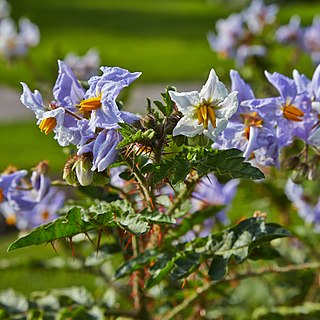 W
WSolanum sisymbriifolium is commonly known as vila-vila, sticky nightshade, red buffalo-bur, the fire-and-ice plant, litchi tomato, or Morelle de Balbis.
 W
WPraecitrullus fistulosus, commonly known as Tinda, also called Indian squash, round melon, Indian round gourd or apple gourd or Indian baby pumpkin, is a squash-like cucurbit grown for its immature fruit, a vegetable especially popular in South Asia. It is the only member of the genus Praecitrullus.
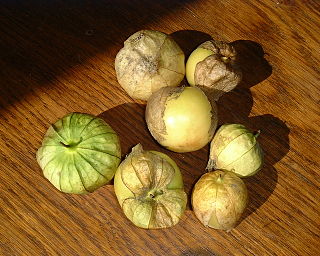 W
WThe tomatillo, also known as the Mexican husk tomato, is a plant of the nightshade family bearing small, spherical and green or green-purple fruit of the same name. Tomatillos originated in Mexico and were cultivated in the pre-Columbian era. A staple of Mexican cuisine, they are eaten raw and cooked in a variety of dishes, particularly salsa verde.
 W
WTrichosanthes cucumerina is a tropical or subtropical vine. Its variety T. cucumerina var. anguina raised for its strikingly long fruit. In Asia, it is eaten immature as a vegetable much like the summer squash and in Africa, the reddish pulp of mature snake gourd is used as an economical substitute for tomato. Common names for the cultivated variety include snake gourd, serpent gourd, chichinda and padwal.
 W
WTrichosanthes dioica, also known as pointed gourd, is a vine plant in the family Cucurbitaceae, similar to cucumber and squash, though unlike those it is perennial. It is a dioecious vine (creeper) plant with heart-shaped leaves (cordate) and is grown on a trellis. The fruits are green with white or no stripes. Size can vary from small and round to thick and long — 2 to 6 inches. It thrives well under a hot to moderately warm and humid climate. The plant remains dormant during the winter season and prefers a fertile, well-drained sandy loam soil due to its susceptibility to water-logging.
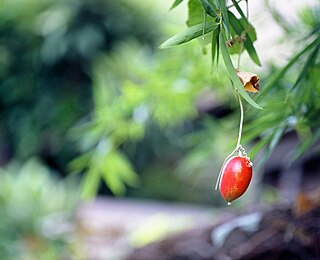 W
WTrichosanthes pilosa is a tropical or semitropical vine bearing an edible fruit. It is native to Japan, Taiwan, India, Malaysia, Vietnam, the Philippines, China and other parts of southeast Asia as well as in Australia. It is known in English as Japanese snake gourd.
 W
WBenincasa hispida, the wax gourd, also called ash gourd, white gourd, winter gourd, tallow gourd, ash pumpkin, winter melon, Chinese preserving melon and (Alu) Puhul, is a vine grown for its very large fruit, eaten as a vegetable when mature.
 W
WThe zucchini, courgette or baby marrow is a summer squash, a vining herbaceous plant whose fruit are harvested when their immature seeds and epicarp (rind) are still soft and edible. It is closely related, but not identical, to the marrow; its fruit may be called marrow when mature.